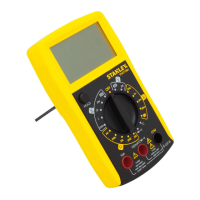3
cover or portions of the case removed or
loosened.
• ALWAYS replace the battery as soon as the
low battery indicator appears. Failure to
do so could lead to possible electric shock or
personal injury due to false readings.
• DO NOT touch any conductor with hand or
skin, and do not ground yourself.
• DO NOT use the meter in a manner not
specied by this manual or the safety
features provided by the meter may be
impaired.
• DO NOT operate this instrument if your
hand, a test lead or the instrument is wet.
• ALWAYS Adhere to local and national safety
codes. Personal protective equipment must
be used to prevent shock and arc blast
injury where hazardous live conductors are
exposed.
• ALWAYS be aware that when an input
terminal is connected to a hazardous live
voltage, this potential can occur at all other
terminals.
• ALWAYS use only 9 V batteries specied
for use with this product. Use of any other
batteries may create a risk of re.
• DO NOT disassemble, service or repair this
product. Repairs performed by unqualied
personnel could result in serious injury.
• DO NOT splash or immerse the unit in water.
• ALWAYS turn off the product when not in
use.
• ALWAYS ensure battery is inserted in the
correct manner, with the correct polarity.
• NEVER intentionally short any battery
terminals.
• DO NOT attempt to charge alkaline batteries.
• DO NOT dispose of batteries in re.
• ALWAYS remove the battery if storing the
unit for over a month.
• DO NOT dispose of this product with
household waste.
• ALWAYS check local codes and properly
dispose of used batteries.
• PLEASE RECYCLE in line with local
provisions for the collection and disposal of
electrical and electronic waste.
• WARNING: To avoid risk of personal
injury and/or possible damage to the meter
or to the equipment under test, follow these
guidelines: If these guidelines are not
followed there is risk of shock.
• Disconnect circuit power and discharge all
capacitors before testing resistance, diode,
continuity and temperature.
• Use the properly rated terminals (function
and range) for your measurements. The
terminals included with this multimeter are
CAT III rated for 300 V 10 A Max.
• Before measuring current, turn off the power
to the circuit before connecting the meter to
the circuit. Remember to place the meter in
series with the circuit.
• Before turning the rotary switch to change
functions, disconnect test leads from the
circuit under test.
Electrical Symbols
Alternating Current
Direct Current
Both direct and alternating
current
Caution, risk of danger, refer to
the operating manual before use.
Caution, risk of electric shock.

